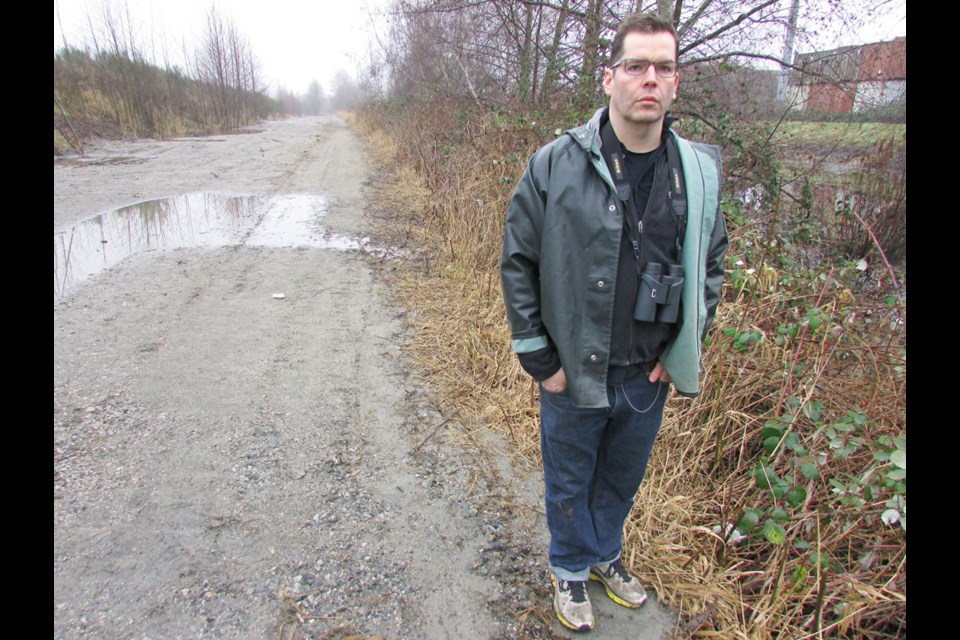A local resident is raising concerns that a south Burnaby development is encroaching on habitat for wildlife and fish.
Cameron MacDonald, a biology instructor at Langara College, lives in the Big Bend area and walks along Byrne Creek. The salmon-bearing stream runs south of the Riverway Golf Course, into the Fraser River, but MacDonald has concerns that a massive development next to the creek is too close to the waterway.
"My main concern is they have a little ecological setback, ... and they've just ploughed it under," he told the NOW, while walking alongside the creek recently.
The setback MacDonald is referring to is a swath of land that functions as a buffer zone between the development and the creekside. At the development site, there was a wide setback zone next to the creek, but that has since been bulldozed and covered with sand, leaving only a couple of metres of buffer zone.
"When the tides are really in, and there's rainfall, the creek is at road level," he said. "I've seen that within a metre."
According to MacDonald, who specializes in ecology, a setback measuring 15 to 30 metres would be ideal for a number of reasons: erosion control, protecting the creek from runoff and providing a sliver of habitat for wildlife.
"You've got 30 centimetres of setback when you really need 30 metres of setback," he said. "As far as I can tell, there's no erosion control here."
According to MacDonald, the lower stretch of Byrne Creek is a tidal estuary that connects to the Fraser and is subject to the pull of the tides. Estuaries, in general, are considered extremely productive environments that are rich in biodiversity.
MacDonald goes birdwatching in the area and has spotted the endangered barn owl, as well as barn swallows, which are listed as threatened by the federal government, and short-eared owls, which are considered a species of concern.
MacDonald also explained that the now-razed habitat corridor is important because it connects the Fraser River to the Riverway Golf Course.
"Any time you remove a connection like that, you're going to impact species diversity," he said.
MacDonald said he contacted the City of Burnaby with his concerns that the developer was working in the setback area but was told as long as they have proper erosion controls in place, it's all above board and that the development had passed an environmental assessment.
"It's a real lost opportunity for the city. There's not a lot of green space in south Burnaby. A little sliver of space would have a big ecological benefit with very little economical cost," MacDonald said.
Lise Townsend, the city's ecosystem planner, told the NOW the owner/developer secured approval about 10 years ago from the city and Fisheries and Oceans Canada to work in the setback area, which included clearing some vegetation and preparing the area with "preload" to compact and stabilize the soil. According to Townsend, the city has a streamside bylaw that determines minimum setback areas for developers working close to waterways, and the minimum for this site is 15 metres from the top of the bank. Townsend also said the plan is to replant the area in the future, possibly within the next year.
"They are required by the city and Fisheries and Oceans Canada to replant and restore that entire area within 15 metres," Townsend said, adding that as a fellow biologist, she understands MacDonald's concerns.
"It can look pretty ugly when you see something that is a construction area in progress," she said. "I haven't had any information that indicates they are not following the conditions of the approvals for working near the stream, but I don't know preciously what they are doing."
Christine Ensing, an environmental services officer with the city, checked the area recently and said the trees were taken out because the area was covered with preload.
"This is something that went through our environment committee years ago, ... those setback areas are still to be put in place. There's nothing there right now, no trees or anything, but that was taken down, because they had to preload the site," she said, adding the sand will be removed and the area replanted.
"Those are little scrubby trees that can come out; that whole area is going to be replanted," she said. "Then the development will occur outside of that. ... Right now, we're in an interim stage. If there is any sediment control, that should be in place to make sure no sand is moving into Byrne Creek."
The NOW also asked who the developer was, but Townsend didn't know, and Lou Pelletier, head of the planning department, did not get back to us, despite repeated requests.



